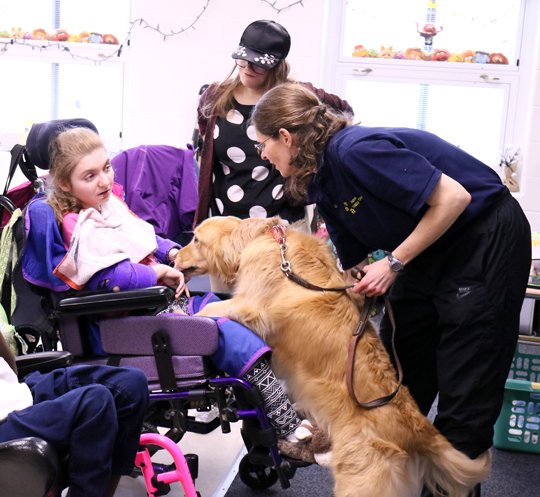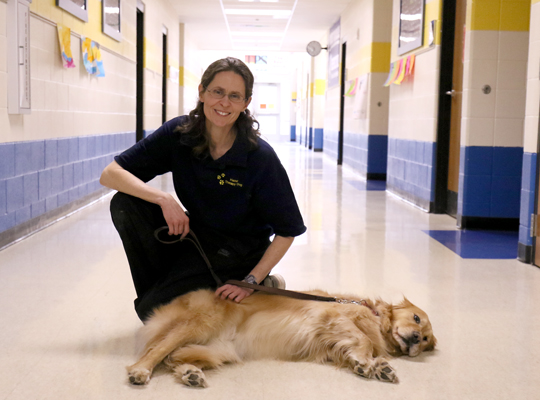Instant smiles. It’s almost a whiteout inside Reynolds Elementary School.
Hazel, the therapy dog, is in the hallway, and happiness abounds.

Marquis, a student at Reynolds Elementary School, petted Hazel, a therapy dog, as owner Dr. Dawn Sandt watched.
“Hazel!” yelled a boy in the preschool special-needs classroom, alerting all to the visitors.
“Do you want to go see Hazel?” teacher Bridget Harding asked as the children walked and crawled toward the therapy dog that laid down and was content literally being the center of attention.
“Get your pets in,” Harding encouraged the kids sitting around their four-legged friend. “Let’s talk about Hazel’s tail today. She’s wagging her tail. When she’s happy, she wags it back and forth. Ricardo, where’s your tail? Do you have a tail?”
Ricardo shook his head no, beaming as he ran his hand over Hazel’s soft coat.
Sandt knelt next to Hazel; she held the dog’s leash and monitored all interactions.

Dr. Dawn Sandt, right, and Reynolds Elementary School teacher Leah Richter, center, watched as Hazel visited Ireland.
Hazel walked up to teacher Leah Richter. After soaking up compliments and a few pats, Hazel melted into the floor and flipped over, and Richter obliged with a belly rub.
“That’s her shtick — she says ‘Hi’ and rolls over,” Sandt said and laughed. “She likes it here.”
Watching it all from her wheelchair was Ireland, who could not stop smiling.
“You love it when Hazel and Dawn come!” Richter said to Ireland.
With encouragement from Sandt, Hazel put her paws on the edge of Ireland’s chair — and the girl grinned.
Then it was time to see the younger medically fragile students.
Marquis, a student seated on the floor, clapped and started humming when Hazel trotted into the room.

Paraprofessional Zippy Keith helped Lee grasp a tennis ball to give to Hazel during a recent visit to Reynolds Elementary School.
The children took turns tossing the ball for the canine. For the first time, Lee picked up a ball and handed it to Hazel.
Meanwhile, teacher Liz Bishop told Tessa she needed to complete her assignment so she could see Hazel.
“We’re all so happy to see Hazel. We enjoy her,” Keith said as the kids petted the retriever.
“Aren’t you glad you got your work done?” Bishop asked Tessa, who lit up when Hazel gently stood up on the side of her wheelchair.
“Thank you for the visit,” paraprofessional Melissa Falkenberg said as Sandt and Hazel left.
“The best part of making the rounds with Hazel is seeing students progress toward their individualized goals and realizing Hazel did contribute to that progress in some way,” Sandt said.

Paraprofessional Melissa Falkenberg smiled as Hazel took her tennis ball to Dylan. The therapy dog regularly visits Reynolds Elementary School.
“We started in the classrooms where students were medically fragile. Hazel does well in those classrooms because she is willing to initiate contact with the children,” Sandt said. “The children have opportunities to track her with their eyes, reach out to pet her, and grasp and drop a ball for her to retrieve.
“We wanted to go into that classroom because the medically fragile population need intensive interventions, and I thought Hazel could help with communication and social interaction, as well as some range of motion activities.”
Indeed, the pretty pooch that will turn 4 in August does just that. Tessa communicated with her assistive device so she could see Hazel, and Lee had a breakthrough by picking up a tennis ball.
“The teachers, nurses and I thought that was pretty extraordinary for [Lee], who is medically fragile and also has sensory issues. The nurse said he had never shown that type of initiative before,” Sandt said.
“I like watching the preschool students interact with Hazel,” she said. “This gives the students a chance to learn about dogs, their body parts, how they move, and how to care for them. The preschool students are learning content knowledge — for example, same vs different — and functional skills like waiting their turn, asking permission to pet, communicating their name and Hazel’s name. These are relevant skills they can use in kindergarten and in the community.”
The duo also visits McTigue Elementary School.
“The administration and teachers within Toledo Public Schools have been wonderful to Hazel, and it is work that makes a difference,” Sandt said. “Wherever we go, the teachers appreciate the opportunity to interact with her.”

Dr. Dawn Sandt said Hazel would go home and sleep after visiting children at Reynolds Elementary School.
“Dawn is deeply committed to working with our school partners to provide support for medically fragile children with special needs along with the educators in these classrooms,” Keil said. “Therapy dogs like Hazel are desperately needed to provide affection, comfort and love, which can help to improve the lives of the children they have visited.
“Watching Dawn and Hazel work together to support these children is heart-warming. Their work is an invaluable service to the community.”
“There is growing evidence that animals in school settings have potential benefits on cognitive and socio-emotional behavior, as well as physiological responses of children,” Sandt said. “However, there is a need for a larger evidence base of studies that are designed with more rigor and adhere to strict protocols for human and animal welfare and safety.”
To that end, Sandt is working with Dr. Janet Hoy-Gerlach, associate professor in the UT Social Work Program and author of the book, “Human-Animal Interactions: A Social Work Guide.” They have applied for a grant to explore how therapy dogs can be used in applied behavior analysis interventions for students with disabilities.
Sandt has another golden retriever, Rusty. The 2-year-old is training to be a therapy dog.
“I can’t imagine doing anything else with the time I have on this earth,” she said as she gave Hazel a treat.